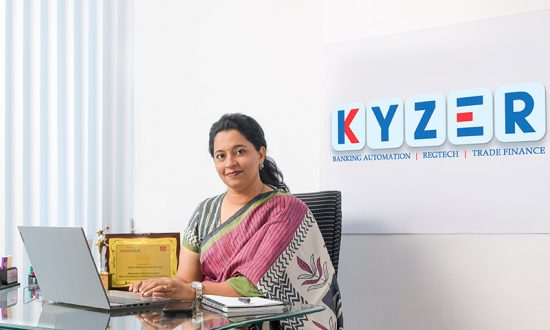Facing major complications during audits for corporates, Supriya Kulkarni co-founded Kyzer Software. It’s one of the leading banking and financial organizations that came into existence in the year 2016. Supriya is, at present, the Managing Director of Kyzer. Supriya possesses more than 19 years of experience in the corporate sector. She completed her bachelor’s degree in Computer Science from Pune University, which further led her to acquire Business Management expertise at Aptech Computers, Bostons Institute, Tech Mahindra, SIS India, and Pioneer Global. She successfully led all the businesses to top positions across all regions. She held a variety of senior leadership roles across sales, marketing, delivery, and market strategy.
The trade finance space has seen a huge influx of capital in the development of fintech solutions to address some of today’s most pressing trade challenges. This has been fuelled by the concept of open banking, which evolved in retail banking.
Based on the principal of open banking, fintechs and mature IT vendors as well as the cash rich super-scale banks are furiously investing in the development of functions and services via APIs. But unfortunately, many smaller and medium sized banks – as well as the corporates – are losing track, unable to keep pace of the development due to lack of resources and specialist knowledge.
So maybe it’s time to take a step back and look at not what is being developed and how, but why?
A former Trade Finance IT company CEO recently summarized the problem of focusing on the technical benefits of open banking:
“No one is interested in cloud and APIs. No one cares about technology.”
It seems mind boggling at first. However, it opens the discussion to look at what lies beneath. APIs are the “what and how” of connecting an ecosystem, but much more important is the “why.” Knowing why is the catalyst to engaging a wider audience, to allowing the smaller, mid-sized banks and corporates to buy into ideas and solutions. So why are we building a more connected world in trade finance?
If you are responsible for the trade finance business in a bank or corporate, you continually need to generate value for your customers. You need to gain competitive advantage, differentiate yourself from the competition by offering more customer-centric, streamlined and efficient digital experience. You need to deliver new features with a fast time-to-market, better workflows and easier to use interfaces.
The trade finance gap is a measure of how much trade is unfinanced versus the potential. Economically, it comes down to the transaction cost being too high in relation to the value of the transaction. There is a significant need to reduce the cost per transaction to intrinsically link trade finance services with existing supply chains, as well as to include a broader spectrum of players in the yet unserved markets.
Being laser focused on the ‘why’ generates value and efficiency which in turn makes space for the ‘how.’
The promise of open banking is to empower the owners of accounts, funds and other assets, emancipating them from the stifling grip of proprietary banking environments. And yes, the technology of open APIs provides guidelines, a framework and standards; it provides real-time connectivity, transparency and speed; but it is entirely dependent on banks of all shape and size using systems that are API-enabled. Open banking brings value for the masses, it should be inclusive and far-reaching and not just a luxury for the megabanks.
So how can smaller and mid-sized banks benefit from a leading API-enabled back-office trade finance processing solution for example?
Simple; the cost and time barriers to adoption need to be lowered:
Provision of specialised End-to-end Trade Finance systems offered with Customer Portal, Comprehensive Trade Finance Workflows, Compliance and Audit frameworks, Regulatory Report Management as a fully personalized solution, the cost is negligible against the business, customer and regulator management benefits, making it economically far more viable. Experience shows that the total return on investment is instant and recovered within a short span of time.
Kyzer Software offers Automated Framework designed exclusively for Trade Finance, Comprehensive Customer Trade Portal and Bank Trade Workflow with built-in Business Rules for both Trade Products & Regulatory Management. Handling trade request initiation, document submissions, alerts & notifications with complete trade information. Enhanced with Straight Thru Transaction Processing by using API & RPA tools.
First Suite offering for Trade Finance Regulatory Management products. Supports multiple Reserve Bank of India, FIU India, Directorate of Rev. Intelligence, DGFT e-BRC reports & submissions.
Typically, the time to integrate a back-office trade finance solution to internal risk, finance and other downstream systems can be reduced from several months to just a few weeks. By default, this also reduces any potential project, resourcing and operational risk.
The icing on the value generation cake however, is when a specialized Trade Finance solution is also connected to the wider trade finance ecosystem (e.g., vessel tracking, fraud prevention, data insights solutions). This accessibility not only increases value for every user, it also dramatically reduces the cost to get there. The number of corporate connections, third party integrations would grow exponentially according to the banks’ business vision going ahead.
So, in summary, let’s forget about technology, about open banking and APIs; let’s talk about generating value, about enabling customers to drive growth, about facilitating a more inclusive, efficient and enhanced service, to banks and in turn to bank’s corporate customers.
Let’s use open banking as a means to open up Trade Finance, to make it more accessible to those smaller businesses who may not previously have had the means.


